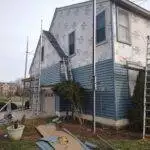3 Things You Need Should Know About The Pipes On Your Roof
Every home has them, yet few homeowners fully understand the importance of roof pipes. These seemingly small components play a huge role in maintaining the health and safety of your home.
At RoofPRO, with over 20 years of roofing experience in Maryland, we’ve seen how small issues with roof pipes can quickly turn into major problems if left unchecked.
In this blog, we will quickly review what a roof pipe is, common problems, maintenance tips, and when to contact a roofing contractor for help with leaks and roof pipe problems.
1. What Are The Pipes On Your Roof
Roof pipes, often seen protruding from your roof, are typically part of your home’s plumbing or ventilation systems. In our recent blog, “What Is On My Roof,” we identified the different types of pipes, vents, and accessories that you’ll find on your roof. These pipes serve various functions, like venting gases, allowing fresh air into plumbing systems, and helping HVAC units operate correctly. Our licensed team has repaired hundreds of vent pipe flashings across Maryland, and we know exactly what to look for when these components begin to fail.
Below is a picture with some of the common pipes coming out of your roof:
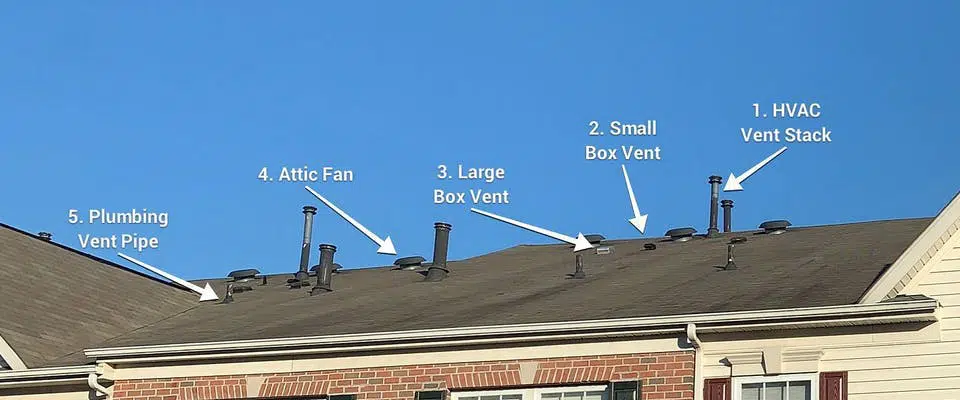
Here’s a quick list to help you learn more about each type of common roof pipe or vent and what it does. Click a title to explore each one:
2. Recognizing Common Problems With Roof Pipes
Knowing what to look for can help you spot issues before they become major problems. Common issues include poor installation of flashing and roofing materials, corrosion, damage, and blockages caused by debris or pests. These common issues can lead to a range of bigger problems, including leaks, interior water damage, or even dangerous gas buildup. Regular inspections and prompt attention to any signs of trouble can save you from costly repairs or damage to your home.
Why You Need to Know About the Pipes on Your Roof
Understanding the roof pipes of your home is an integral part of maintaining your property’s overall health and safety. Here is a quick list of reasons why you need to know about the pipes on your roof:
- Protect Your Home’s Structural Integrity
- Ensure Proper Ventilation
- Promote Energy Efficiency
- Save on Repair Costs
3) How to Properly Maintain Your Roofing Vents & Accessories
The health of the pipes on your roof depends heavily on regular maintenance. Whether you’re comfortable doing some basic tasks yourself or you prefer to leave all maintenance to a roofing contractor, understanding the maintenance process is crucial. Tasks might include clearing debris, and checking for signs of leaks, corrosion, or damage. Remember, safety first – always ensure you have the correct equipment and knowledge before going onto your roof to attempt DIY work.
Common Types of Roof Vent Pipes
HVAC Furnace Vent Pipes
These vent pipes expel exhaust gases from your furnace or water heater, ensuring harmful gases like carbon monoxide don’t accumulate inside your home.
- Materials: Metal, such as aluminum or galvanized steel, due to their ability to withstand high temperatures.
- Special Features: Double-wall or insulated pipes are often used to prevent condensation.
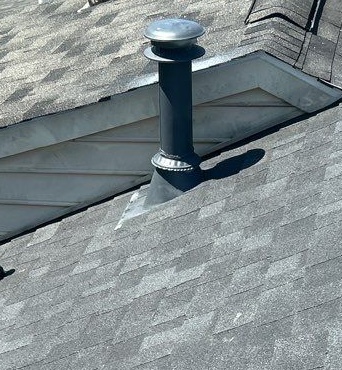
Small Box Vent
Small box vents are used to expel air from interior exhaust systems, such as bathroom fans or kitchen range hoods. They help remove moist or stale air from the home, reducing the risk of mold, mildew, and humidity-related damage inside.
- Materials: Galvanized steel, aluminum, or heavy-duty plastic.
- Location: Mounted on the roof, typically above bathrooms or kitchens, with ductwork connecting the fan to the vent.
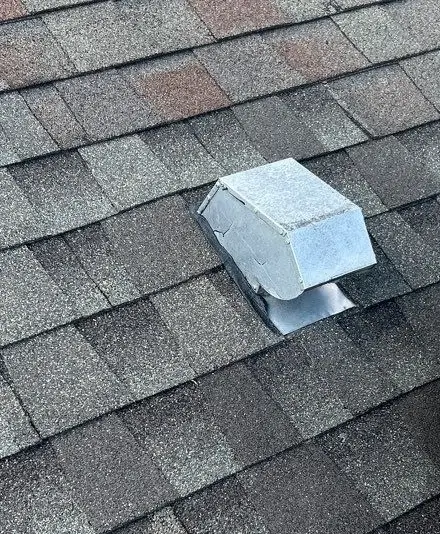
Large Box Vent
Large box vents are designed to vent hot air from the attic, helping regulate your home’s temperature and reduce moisture buildup. By allowing heat and humidity to escape, they protect your roofing materials and improve overall energy efficiency.
- Materials: Galvanized steel, aluminum, or UV-resistant plastic.
- Location: Installed near the upper areas of the roof, typically spaced evenly to promote passive airflow throughout the attic.
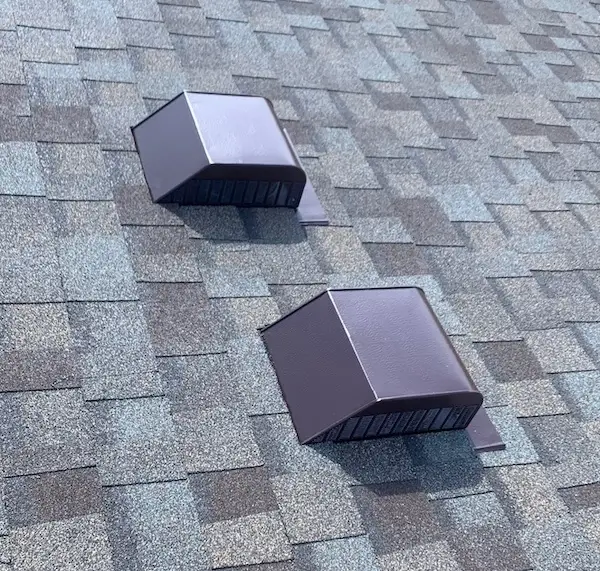
Large Box Vent
Large box vents are designed to vent hot air from the attic, helping regulate your home’s temperature and reduce moisture buildup. By allowing heat and humidity to escape, they protect your roofing materials and improve overall energy efficiency.
- Materials: Galvanized steel, aluminum, or UV-resistant plastic.
- Location: Installed near the upper areas of the roof, typically spaced evenly to promote passive airflow throughout the attic.
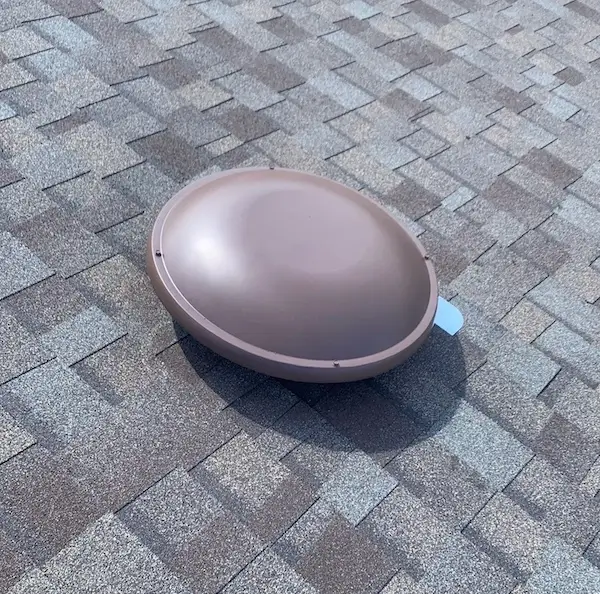
Plumbing Vent Pipes
These pipes are part of your home’s plumbing system. They vent sewer gases out of your home, preventing foul odors from backing up into your drains. They also allow fresh air into the plumbing system to maintain proper water flow and drainage.
- Materials: PVC, ABS plastic, or metal.
- Location: These typically protrude through the roof vertically and are connected to your home’s plumbing stack.

Dryer Vent Pipes
These pipes allow hot, moist air and lint from your dryer to exit your home. Proper venting prevents fire hazards and helps your dryer operate efficiently.
- Materials: Flexible aluminum or rigid metal ductwork.
- Considerations: Dryer vent pipes need regular cleaning to avoid lint buildup.
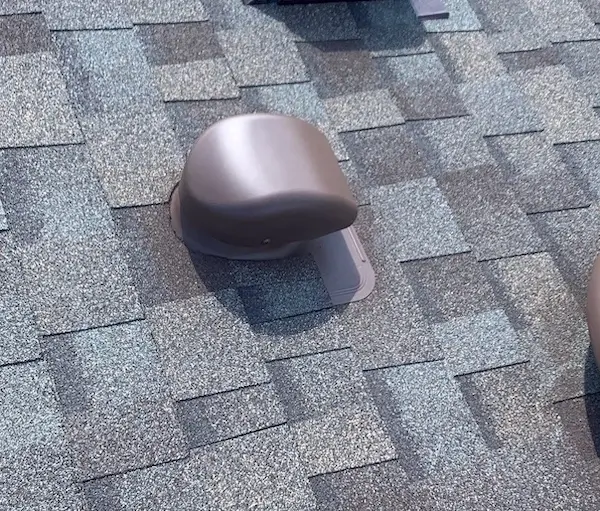
Ventilation Pipes (Attic and Roof Ventilation)
These pipes and vents are part of your home’s roof ventilation system, helping to regulate attic temperature and moisture. They prevent mold growth, ice dams, and premature roofing wear.
- Materials: Typically metal or high-quality plastic.
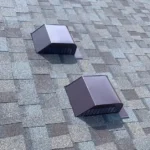

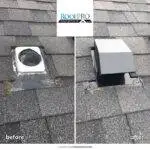
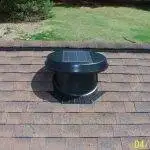
What To Do When There Is A Leaky Pipe On My Roof
Now that you are a bit more familiar with the roof pipes and systems, let’s discuss what to do if you have a leak from those pipes and how to stop the leak. Any penetration on a roof provides an opportunity for a leak. In our blog, How to Inspect a Leak From a Vent Pipe, we discuss in greater detail the method we take to find a leak. For now, I’ll give you the bullet points of this inspection.
How to inspect roof pipes and vents:
- Measure the leak from inside the room. This will help you find the exact spot during the following steps.
- Go into the attic space if possible to see the leak from above the ceiling.
- Inspect the bottom side of the roof.
- Always take pictures.
- Inspect the roof using the measurements and pictures to pinpoint the exact location.
Need help confirming the leak source? If your pipe flashing looks worn or you’re dealing with a leak, schedule a free roof inspection. We’ll take care of it quickly.
Other Helpful Information to Know About a Plumbing Vent Pipe Leak
Unfortunately, the flashing designed for your plumbing vent pipe is typically one of the first things to leak on a roof. With that in mind, let’s focus on some helpful tips to resolve any potential leaks from the plumbing vent on your roof.
- Whenever there is a pipe sticking up from your roof, there is also a specifically designed type of flashing for that pipe.
- Your shingle might be a 25-year or 50-year shingle, but few pipe flashings are actually designed for that length of time.
- Most builders install a pipe flashing that lasts approximately 7 years.
- Learn how to pick the right flashing for your vent pipe
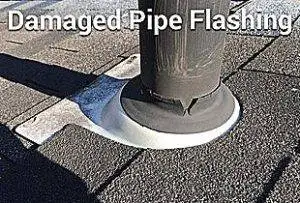
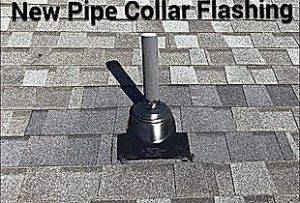
How the Plumbing Vent Works
The plumbing vent pipe you see on your roof is attached to all the sinks, toilets, and water sources in your home, which ultimately drain into the sewer. There are two main reasons for these plumbing vent pipes.
- To help the water drain out of your house, just like the tiny hole in your coffee lid functions.
- Prevent sewer gases from entering back into the house.
When to Call a Professional: Signs and Symptoms
There are instances when DIY isn’t enough, and a professional roofer is needed to help repair or replace your roof pipes. If you’ve noticed consistent issues, severe damage, or if your pipes are old and possibly due for replacement, a roofing professional can provide the necessary recommendations and services. Professionals can also perform regular maintenance and inspections, so if you’re uncomfortable doing this yourself, don’t hesitate to seek their assistance. RoofPRO is the go-to Maryland Roofing contractor for all of your inspection, maintenance, repair, and replacement needs. Contact us today to schedule an appointment with a roofing expert!
Want to learn more about the structure of your roof?
More About Roof Vents and System Components
Understanding the pipes and vents on your roof is just one piece of the puzzle. Each element plays a role in how air and moisture move through your attic space. For a full breakdown of how every layer and connection works together, visit our overview of the parts of a roof system. You can also explore how gable, soffit, and ridge vents differ to see how each contributes to balanced attic ventilation.
When it comes to air exhaust, ridge vents are a popular choice — but they’re not the only one. Our guide comparing ridge vents vs. attic fans explains when each performs best and how to choose the right option for your home. If you want a closer look at how these vents work together, check out our detailed discussion on soffit and ridge vents for insights into airflow balance and long-term efficiency.
And since every roof has unique penetrations — from plumbing stacks to exhaust pipes — it helps to know what else might be installed up there. Visit what is on my roof — learn about the different pipes on your roof to identify each component and understand how proper sealing and flashing keep water out. Together, these resources give you a complete view of how your roof’s venting system protects your home year-round.



